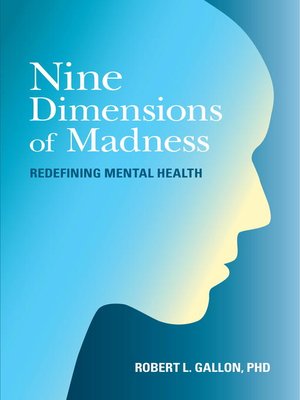
Sign up to save your library
With an OverDrive account, you can save your favorite libraries for at-a-glance information about availability. Find out more about OverDrive accounts.
Find this title in Libby, the library reading app by OverDrive.



Search for a digital library with this title
Title found at these libraries:
| Library Name | Distance |
|---|---|
| Loading... |
In a book that reframes the mental health debate, Robert L. Gallon challenges the widely-held notion that mental disorders are medical diseases. Drawing on his extensive experience as a psychologist who has worked with thousands of patients, he argues that there are no objective indicators of mental disorders and therefore no way of drawing a distinct line between people who have them and people who don't. He outlines an alternative to the disease model defined by nine dimensions of dysfunction that encompass the range of human dysfunctions typically classified as mental disorders. He explains the origin of these problems, not as chemical imbalances and genetic abnormalities, but as the complex interaction of biological, psychological and social factors, called the Biopsychosocial model.
Gallon explains the history of psychiatry and how it came to develop a medical model that codifies mental disorders in the psychiatric bible, the Diagnostic and Statistical Manual of Mental Disorders (DSM), now in its fifth edition. He demonstrates how, in 1950s and 1960s when the miracle psychiatric drugs came on the market, it was to the great economic advantage of both pharmaceutical companies and psychiatrists to describe people's problems in the language of medicine. His alternative to this disease model suggests descriptive types—Reality Misperception, Mood Dysfunction, Anxiety, Cognitive Competence, Social Competence, Somatoform Dysfunction, Substance Dependence, Motivation and Impulse Control, and Socialization Dysfunction—that we can construct to discuss the kinds and severities of problems people experience. These are not discrete abnormalities, but are sorts of dysfunction that can be placed on dimensions of dysfunction.
Table of Contents
Part I History of Madness
1. Introduction and Some Definitions
2. How madness became Medical 3. The Rise of Psychiatric Diagnosis 4. An Alternative Model
Part II Dimensions of Madness 5. Reality Misperception
6. Mood Dysfunction
7. Anxiety
8. Cognitive Competence
9. Social Competence
10. Somatoform Dysfunction
11. Substance Dependence
12. Motivation and Impulse Control 13. Socialization Dysfunction
Part III Treatment and Other Issues 14. What is Mental Health Treatment?
15. The Future
Gallon explains the history of psychiatry and how it came to develop a medical model that codifies mental disorders in the psychiatric bible, the Diagnostic and Statistical Manual of Mental Disorders (DSM), now in its fifth edition. He demonstrates how, in 1950s and 1960s when the miracle psychiatric drugs came on the market, it was to the great economic advantage of both pharmaceutical companies and psychiatrists to describe people's problems in the language of medicine. His alternative to this disease model suggests descriptive types—Reality Misperception, Mood Dysfunction, Anxiety, Cognitive Competence, Social Competence, Somatoform Dysfunction, Substance Dependence, Motivation and Impulse Control, and Socialization Dysfunction—that we can construct to discuss the kinds and severities of problems people experience. These are not discrete abnormalities, but are sorts of dysfunction that can be placed on dimensions of dysfunction.
Table of Contents
Part I History of Madness
1. Introduction and Some Definitions
2. How madness became Medical 3. The Rise of Psychiatric Diagnosis 4. An Alternative Model
Part II Dimensions of Madness 5. Reality Misperception
6. Mood Dysfunction
7. Anxiety
8. Cognitive Competence
9. Social Competence
10. Somatoform Dysfunction
11. Substance Dependence
12. Motivation and Impulse Control 13. Socialization Dysfunction
Part III Treatment and Other Issues 14. What is Mental Health Treatment?
15. The Future







